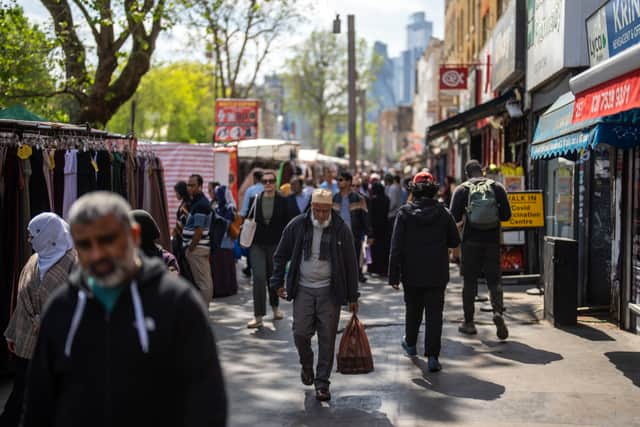15-minute neighbourhoods make London ‘a very lovely city’, committee told - but are not what makes it great
and live on Freeview channel 276
The number of so-called ‘15-minute neighbourhoods’ in London make the capital “a very lovely city to live in, a very convivial city”, a City Hall committee has been told - but they are not what makes it a “great city”.
The planning and regeneration committee met this week to ask the question of a panel of experts and stakeholders; is London already a 15-minute city?
Advertisement
Hide AdAdvertisement
Hide AdThe term, a planning concept which aims to deliver neighbourhoods that provide local access to essential amenities, has increasingly entered the public domain in recent years, despite existing under various names for decades.
Concerns have been raised by various parties due to its perceived limiting of certain freedoms, primarily its intended reduction of residents’ reliance on motor vehicles. Nick Fletcher, the Conservative MP for the South Yorkshire constituency of the Don Valley, earlier this year referred to it as an “internationalist socialist concept” in parliament.
As highlighted by Nicholas Boys Smith, director at Create Streets, during the session: “Until about 120 years ago, we all had to live in 15-minute cities, or 15-minute towns, because it was really the only option available. And then for understandable reasons, about 100 years ago, we invented these things called the motor cars, and we got confused, and assumed because cars are brilliant at giving individual liberty to drive around the countryside and suburbs and out around the whole country, that therefore it was necessary and right to also make it very easy to move around in cars very quickly in our city centres.”
Mr Boys Smith added that what the 15-minute city concept attempts to do is re-package an historic idea, “of something we’ve sort of always known but we forgot for 100 years”.


Advertisement
Hide AdAdvertisement
Hide AdAccording to City Hall, London has more than 600 high streets, and 90% of the city's residents already live within 10 minutes of their local centre.
The varying needs and densities across London do however vary greatly, and the issue of how the 15-minute city concept is applied was a common concern referenced by assembly members (AM) throughout the three-hour meeting.
Tory AM Emma Best spoke of her own local authority, Waltham Forest, in which she said there are substantial differences when comparing the southern end of the borough to the north.
Catherine Gall, executive director at Chaire ETI, said it is important to think of the concept not strictly in terms of 15 minutes, but rather how those key requirements are delivered locally.
Advertisement
Hide AdAdvertisement
Hide Ad“Don’t be focussed on the 15-minute side,” she said. “It’s really, what are the needs you have, what are the three or four things you really need to do, let’s look at where the amenities are, let’s look at what else we can change and what else do we need to do.”
Responding to separate questioning from Labour AM Elly Baker, who raised the issue of applying the scheme to Londoners who need to access things further afield, Ms Gall said: “Again, the question is not how do you make everybody fit within this framework. The question is really how do you create an environment, and that requires that people will need to change their behaviour and sometimes even their jobs.
"But they don’t have to comply with the model. The model is not something to achieve or to live within, like you are either in or you are out. It’s an approach, it’s a philosophical approach.”
Jonathan Lloyd, corporate director of strategy and change at Waltham Forest Council, which has been a leader in implementing healthy streets schemes such as low-traffic neighbourhoods (LTN), told AMs the local authority’s understanding is that the experience of a place mattered as much as the specific amenities provided.
Advertisement
Hide AdAdvertisement
Hide AdThat may be having police officers more visible, he said, or residents feeling they could grow old in a particular neighbourhood.
Given some of the backlash to the ‘15-minute city’ label, and Ms Gall’s insistence the time-stamp is not the key tenet of the concept, Ms Best asked towards the session's end: “Should we just stop using that term now?”
Matthew McCartney, senior researcher at the Charter Cities Institute, largely agreed, responding: “Why not forget it? It’s just the latest incarnation of a long list of exactly the same thing.”
That does not mean the concept is without use, he later added, with the proximity of many neighbourhoods to cafes, pubs and so-on a major plus in London.
Advertisement
Hide AdAdvertisement
Hide AdHowever, Mr McCartney continued to say it is the accessibility of such large swathes of London within an hour's journey, which for him includes the West End, that elevates the capital from simply being a “convivial city”.
“I think 15-minute neighbourhoods make London a very lovely city to live in, a very convivial city,” he said. “But I don’t think it’s what makes London a great city.”
Comment Guidelines
National World encourages reader discussion on our stories. User feedback, insights and back-and-forth exchanges add a rich layer of context to reporting. Please review our Community Guidelines before commenting.
